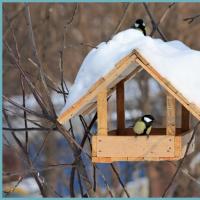Mushroom bed. Mushroom bed in the country. Why are they so moody
The purchase sounds enticingly simple application - "just add water!". No matter how it is, everything is much more complicated.
1. The set of the mushroom bed includes a plastic container with mycelium, a mineral additive to increase fruiting (a couple of bags with white powder) and two beds with a substrate (dry sawdust).
2. The package with the mineral supplement should be dissolved in 1200 ml of hot water, it is possible from the tap.
3. Open beds with sawdust must be filled with the resulting hot solution with a mineral additive.
4. After adding a hot solution to the beds, they must be tightly closed with a lid and additionally heated in a water bath for an hour and a half.
5. Remove the beds from the water bath and cool to room temperature.
6. Put on new rubber gloves on your hands and open the beds and container with mycelium.
7. In the beds, free the central channel from the substrate and make a hole in the safety valve.
8. The mycelium should be divided into two parts, carefully chopped in hands and filled with it in the central channel of the bed.
9. After filling the canal, the mycelium should be lightly compacted with your fingers and the bed should be closed.
10. After completing all the procedures, the bed must be returned to the box and transferred to the shade. The room temperature should be 22-24˚С.
11. During the first four weeks the mycelium grows in the substrate, the next three weeks the mushroom block ripens. From the eighth week, the formation of mushroom bodies begins. At this stage, the beds should be moved for 2-3 days to a room with a low temperature (5-10˚С).
12. Then you need to carefully bend the edges of the box and open the top of the bag. Rearrange the garden bed in the fruiting room. Where, throughout the entire fruiting period, it is necessary to maintain the temperature in the range of 14-16˚С and humidity in the range of 80-90%.
13. The buds of boletus - primordia - appear as early as 7-9 days, and they will grow to a full-fledged mushroom in 5 days.
14. For use, you need to pluck the whole druse completely.
15. During the growth period, mushrooms require intensive moisture, it can be carried out using a household sprayer for indoor flowers. So that the moisture does not evaporate instantly, you can make a polyethylene cap with corners cut off for ventilation and cover the garden with it.
16. After the first harvest, the bed should be allowed to rest for a week by closing the top of the bag.
17. Before re-fruiting, the garden bed must be transferred to a cool place with a temperature of 14-16˚С and humidity up to 90%.
18. Boletus mushrooms bear fruit several times a season.
19. If the bed began to weigh less than half a kilogram, it must be removed and immersed in cold water for five hours.
Where in a modern apartment can I find a room with a temperature of 16 degrees and a humidity of 80-90%?
How to grow mushrooms in the country and in the garden in the garden - miracles - mushrooms in the garden? What mushroom picker has not dreamed of meadows covered with mushrooms. I came to the forest edge, and there were apparently invisible mushrooms. Such picturesque pictures are imagined by lovers of "quiet hunting", gathering in the forest for their favorite trophies. But a trip to the forest is not always successful. Sometimes an hour-long search for forest gifts ends in complete failure, and you have to return home with empty baskets.
Forestry gifts have ceased to provide for the rapidly growing demand for mushrooms. Forest delicacies are currently very popular and in high demand.
Mushroom production is a very profitable business. Agricultural farms grow mushrooms and oyster mushrooms. The industrial method of growing mushrooms, thanks to the growing demand for a unique food product, is gaining momentum.
Mushrooms grown on shelves are inferior in taste to forest beauties, but such products are in great demand due to their availability throughout the year. Conveyor production of champignons and oyster mushrooms is able to provide an excellent product all year round.
Most vegetable farms constantly supply mushroom products to supermarket shelves, regardless of the season. Exciting forest walks are replaced by an ordinary trip to the supermarket, where you can definitely find mushroom products. In winter, when forest lands are covered with snow, the supply of mushrooms to the trading network does not stop - this is a huge advantage of mushroom growing vegetable farms.
Industrial hangars and mushroom farms are an excellent solution to the problem of supplying unique delicacies. But what gardener or vegetable grower cannot resist the temptation to arrange a small forest glade in his garden.
Very often, among vegetables and horticultural crops, you can find forest gifts - edible mushrooms. Amateur gardeners successfully grow chanterelles, boletus and mushrooms, russula and milk mushrooms, oyster mushrooms and champignons. To tame forest beauties is the dream of more than one generation of gardeners. But he is in no hurry to reveal his secrets. Several dozen species of mushrooms have ceased to be only wild-growing.
The most affordable representatives that can be grown in the garden are oyster mushrooms. and mushroom. They grow well on any plant residues, such as: straw, hay, oil production waste, sawdust and shavings of all kinds of deciduous trees.
Porcini mushrooms, chanterelles, boletus and saffron milk caps, the more refined representatives of the mushroom kingdom, will feel cozy and comfortable on compost made from sifted garden soil and deciduous humus. Small mushroom spots can be arranged in the garden.
In shady areas of the garden, a small area is allocated for a mushroom pit. It is enough to deepen the pit by 30 centimeters. The finished pit is filled with a pre-prepared, nutritious soil mixture. The soil mixture is placed in the pit in layers. The bottom is covered with fallen, rotted leaves, grass, wood shavings or sawdust. A layer of dung or garden soil is poured onto the nutrient pad. The leveled layer of soil is evenly covered with grain mycelium, spreading it over the entire surface. The mycelium is sprinkled with a three-centimeter layer of manure or garden soil. And finally, the last will be a five-centimeter layer of garden soil. The mushroom pit is regularly moistened with sprinkling. The first garden mushrooms will appear in about two months.
In a garden, with regular care, mushrooms in an equipped pit can be harvested from May to late autumn. Such a mushroom bed will last at least five years. In the same way, you can grow mushrooms in utility rooms, basements, sheds, garages and other outbuildings, replacing the foundation pit with boxes.
The arrangement of a mushroom bed is similar to the arrangement of a foundation pit. The boxes are placed in the corners of outbuildings with diffused sunlight. In the absence of access to natural light, a four-hour electric light is provided. Rooms with mushroom boxes should be well ventilated with sufficient air humidity. The first crop will appear in the same time frame as with the pit cultivation method.
Edible mushrooms have a unique taste and smell. Thanks to their nutritional value, they have become favorite delicacies in all countries of the world. Mushroom picking in the woodlands is an exciting and rewarding activity. Communicating with wildlife brings joy. Returning from the forest, mushroom pickers, along with full baskets of forest gifts, bring with them a lot of impressions of communicating with wildlife. But no less exciting is the cultivation of forest gifts in your garden. The first mushrooms in the garden will bring no less joy.
How to grow mushrooms in the country and in the garden in the garden video tips:
How to grow mushrooms in the country and in the garden in the garden How to grow mushrooms in the country and in the garden in the garden
And so the best mushrooms for home breeding, as you know perfectly well, are oyster mushrooms - these are very unpretentious and fast-growing mushrooms, they will grow on almost everything that contains cellulose.
For growing at home, mushroom blocks are used, they are made as follows, a plastic bag is filled with a sterilized substrate, such as straw, sawdust, sunflower husk or buckwheat. After filling the block, the contents are infected with a strain of oyster mushroom, mainly grain mycelium that can be easily bought on the Internet, and even better from people who are professionally growing mushrooms in your area.
But this process is quite laborious and the blocks will take up space in one or another room, there is the best and simplest of the simple ones that you can imagine, but it consists in the following in the summer cottage you need to choose a very shady place in advance, ideally a place near the fence in the shade of the crown of a tree, and it is also desirable that there be some kind of structure nearby in the form of a barn or a bath, so that rainwater from the roof constantly moistens and moistens this place.
Then you need to pick up cuts of trees with a diameter of at least 15 cm, and the more the better, in height from 50 to 100 cm, the selected stumps need to be thoroughly soaked for a day in a large container, or there is simply nothing terrible in a puddle, but the most important thing, according to the author chocks must strictly have a bark, this is very, very important, because it retains moisture.
A couple of handfuls of grain mycelium are placed on the resulting pillow and a pre-soaked stump is placed, sprinkled lightly with earth and, according to the author's advice, it is imperative to water the mushroom bed.
For better clarity, the summer resident presented photographs of the step-by-step creation of this bed, by looking at which you can easily figure everything out and understand everything. But before you start viewing, you should study the necessary list of materials and tools for creating a garden.
Materials (edit)
1) cuts of trees, hemp, logs
2) grain mycelium
3) sunflower husk or wheat
Instruments
1) hacksaw
2) shovel
Smoothed out, removed all unnecessary.

I put some husk on the bottom of the hole for feeding.

Then he takes a couple of handfuls of grain mycelium and places it neatly on the resulting pillow.

Here's what happens.

He leveled everything just as neatly.


And actually slightly sprinkled with earth.

Here, in a shady place, mushrooms will grow at the author's dacha.

If you plant in early spring, then the harvest can be obtained in the fall. These hemp will last at least 5 years. And then came the golden autumn, and the harvest arrived.







That's all, I hope you enjoyed it) Thank you for your attention! Visit us more often, we have something to read and see.
Transplanting a tree
The mycosis fungus forms a fungus root with all trees of this species within a radius of several tens or even hundreds of meters. Transplanting a small tree from the forest, under which the desired mushroom is already growing, is a proven method. After transplanting pine, spruce or birch about a meter high, mushrooms can appear in 4-5 years.
Choose the type of tree in accordance with the preferences of the mushroom:
Birches get along well with porcini mushroom, black milk mushroom, red boletus. Before replanting a birch with a porcini mushroom, you need to make sure that no oaks grow in the forest nearby, otherwise the porcini mushroom will form mycorrhiza primarily with an oak.
With pine you can try to transplant the pine boletus form. It is good to transfer a small pine tree with a granular oil can to the garden.
With spruce transplanted mushrooms - delicacy and spruce (just take into account that he does not like lime soil).
With aspen - of course, the boletus is red.

Among the listed mushrooms, quick fruiting can be expected only from red boletus. The rest form fruiting bodies under mature trees.
Sowing a spore
Edible mushrooms growing on dead trees bear fruit 2-3 times a year for 5-7 years.
They can only be grown on hardwood logs: birch, willow, alder, maple. Trunks of conifers and stone fruits are not used for these purposes. It is better to harvest and store logs for sowing in late autumn and winter (in the warm season, rotten microflora quickly occupy the wood) from the trunks of living healthy trees in order to populate them with mycelium in the spring.
Dead wood, trees infected with stem rot, and old, semi-decayed wood are not suitable for growing such mushrooms. There are too many competing fungi in their tissues: the cultural mycelium will develop poorly or not at all to take root.
Going to do "mushroom business", the gardener must think. This can be reflected in the appearance of his garden. Another important consideration is whether it will be convenient to work with lengths of logs? After all, they are quite massive and voluminous: the thickness of the logs should be at least 20 cm, the length - from 40 cm.
For those who find this method too laborious and costly and who are sorry to destroy healthy trees, an easier and more intensive way can be offered: sow the substrate from the crushed branches with mycelium.
With this technology, mushrooms give a greater yield and bear fruit more often - from spring to late autumn. The growing mycelium binds and "cements" the particles of the substrate, making it homogeneous and durable. Substrate blocks sprouted with mycelium can be freed from polyethylene and covered with a kraft paper or burlap sheath.
 How to connect to wifi without knowing the password
How to connect to wifi without knowing the password Internet at school - how it is protected
Internet at school - how it is protected Complete despair: how to survive the storm of life
Complete despair: how to survive the storm of life Application of marking on metal Application of a barcode on a product
Application of marking on metal Application of a barcode on a product Inkjet technology
Inkjet technology Dartsya Tarkovska about a creative career and the phenomenon of DIY
Dartsya Tarkovska about a creative career and the phenomenon of DIY What to make a bird feeder
What to make a bird feeder